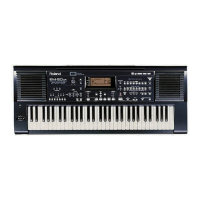
Do you have a question about the Roland EM-50 OR and is the answer not in the manual?
| Brand | Roland |
|---|---|
| Model | EM-50 OR |
| Category | Electronic Keyboard |
| Language | English |
Details compliance with FCC rules for digital devices.
Sensor for expressive performance control via hand movement.
Allows custom tuning of notes by quarter tones.
Real-time accompaniment variation and complexity adjustment.
For saving internal settings and loading new styles.
Advice on power connections, placement, and environmental factors.
Recommendations for cleaning and managing memory data.
Best practices for handling and preserving floppy disks.
Describes D Beam, Scale Memory, Oriental Scale, Volume, and LCD Contrast.
Explains the functions of Demo, Balance, Reverb, and Chorus buttons.
Details on MIDI IN/OUT, Sustain, Input, Output, and DC IN jacks.
Steps to connect and power on the instrument.
Instructions for accessing and playing various demo types.
Introduction to the Arranger and its automatic accompaniment features.
How to start, stop, and synchronize music style playback.
Utilizing introductory, transitional, and concluding musical phrases.
Procedures for selecting different categories of music styles.
Adjusting accompaniment complexity and arrangement.
Blending parts from two music styles for new sounds.
Tempo locking and quick style-specific settings.
Function to add automatic harmony to melodies.
Modifying playback speed and BPM lock indicator.
Adjusting individual accompaniment part volumes.
Using the entire keyboard for single parts without splitting.
Choosing and layering sounds for right-hand playing.
Browsing and choosing instrument sounds and their alternatives.
Adjusting key pitches and saving personalized tunings.
Specifying which parts are affected by scale settings.
Adjusting how playing dynamics influence sound output.
Using hand movements over a sensor for musical expression.
Utilizing the pitch bend lever and sustain footswitch.
Activating and managing the built-in digital effects.
Adjusting the overall pitch and octave of notes.
Fine-tuning the balance and power state of Upper parts.
Customizing the split point for Organ mode.
Choosing sounds for the keyboard sections.
Utilizing drum backing in Organ mode.
Disabling the automatic manual bass line.
Fine-tuning the volume levels of Organ mode parts.
Choosing different drum sound collections for M.Drums.
Accessing drum sounds outside the standard range.
Managing the balance of M.Drums parts.
Clearing recorded songs.
Initial steps for recording songs with the Arranger.
Overdubbing melodies and refining recordings.
Steps for capturing organ performances.
Playing back recorded musical pieces.
Steps for capturing piano performances.
Using M.Drums for recording drum tracks.
Adjusting the playback speed of recorded songs.
Procedures for saving songs to a floppy disk.
Detailed steps for saving songs to a floppy disk.
Preparing disks for use with the instrument.
Procedures for saving and naming recorded songs.
Navigating through song playback.
Programming and executing playback loops.
Loading and playing external MIDI data files.
Removing parts from playback to play along live.
Connecting external audio sources and devices.
Modifying screen readability for different lighting conditions.
Disabling specific features for teaching environments.
Understanding and adjusting the complexity levels of styles.
Explaining morphing levels and how to select a 'B' style.
Choosing a secondary style for morphing.
Transferring styles from floppy disk to temporary memory.
Understanding on-screen prompts during style loading.
Saving current instrument configurations.
Important notes and exiting the User Program mode.
How to select and load saved user programs.
Keeping specific settings when changing programs.
Preserving transpose settings across program changes.
Step-by-step guide for parameter modification.
Overview of adjustable parameters like Write Protect, Master Tune, Splits.
Settings for octave, drum shift, transpose, and D Beam control.
Configuring pitch bend range and D Beam functions.
Chord recognition and memory functions for accompaniment.
Selecting effect types and adjusting scale tunings.
Managing song parts and their interaction with user settings.
Tempo locking and altering bass part behavior.
Restoring factory default parameter values.
General steps for configuring MIDI settings.
MIDI settings for Arranger playback.
Configuring channels for instrument parts and filtering MIDI messages.
Synchronizing the EM-50 OR with external MIDI devices.
Managing keyboard connection and MIDI default recall.
MIDI configuration specific to song playback.
Transferring instrument settings to a computer or sequencer.
Loading settings back into the keyboard via MIDI.
Troubleshooting common SysEx data transfer issues.
Transferring User Programs and Custom Styles from floppy.
Storing Songs, User Programs, and Custom Styles.
Procedures for saving songs and resolving disk errors.
Removing unwanted files from a floppy disk.
Creating duplicate copies of floppy disks.
Backing up the current system software to disk.
Installing new system software from disk.
Installing system updates using a MIDI connection.
Adding new music styles from disk to custom slots.
A list of individuals and entities thanked by Roland.
Details on keyboard, display, power, and basic functions.
Information on tones, styles, effects, and controllers.